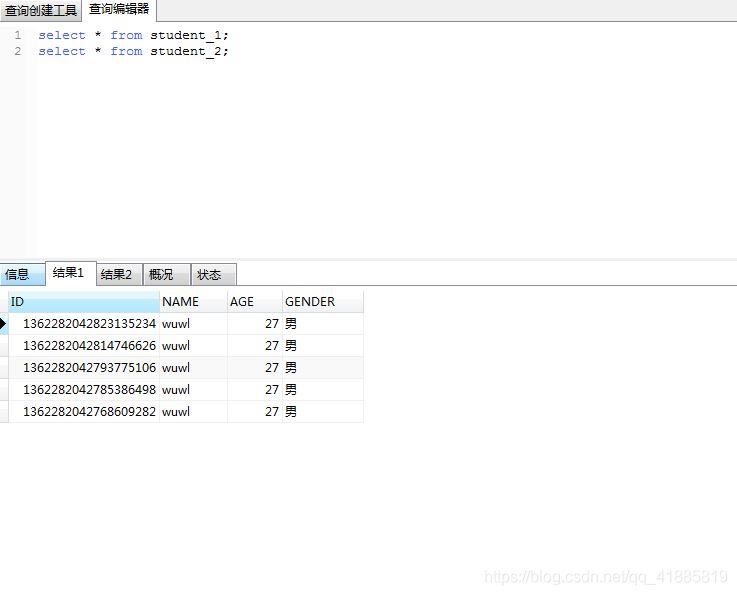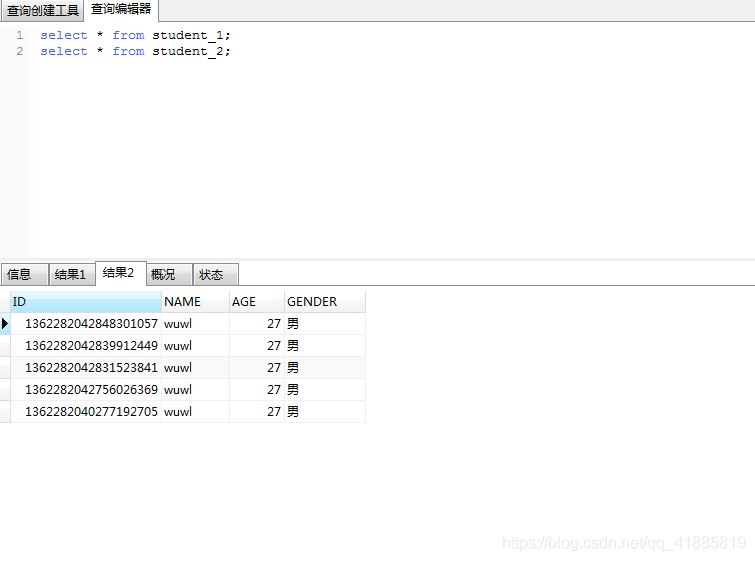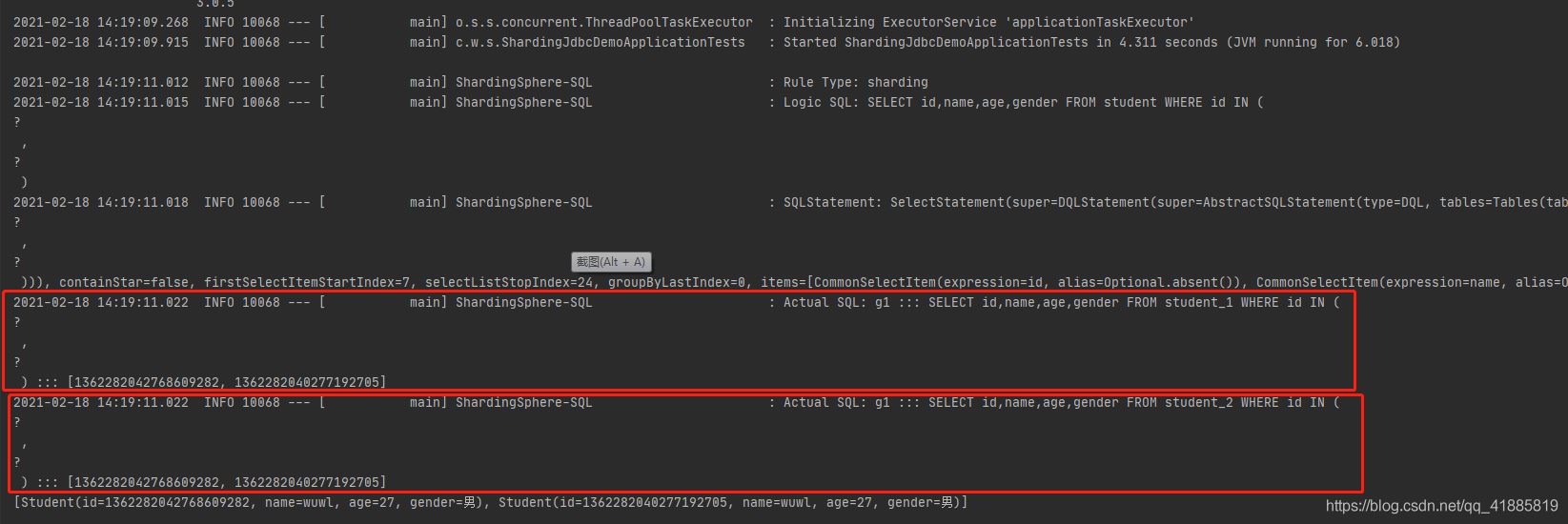您好,登錄后才能下訂單哦!
您好,登錄后才能下訂單哦!
這篇文章主要介紹“怎么使用sharding-jdbc實現水平分表”,在日常操作中,相信很多人在怎么使用sharding-jdbc實現水平分表問題上存在疑惑,小編查閱了各式資料,整理出簡單好用的操作方法,希望對大家解答”怎么使用sharding-jdbc實現水平分表”的疑惑有所幫助!接下來,請跟著小編一起來學習吧!
CREATE TABLE `student_1` ( `ID` bigint(20) NOT NULL , `NAME` varchar(50) CHARACTER SET utf8mb4 COLLATE utf8mb4_bin NOT NULL , `AGE` int(11) NOT NULL , `GENDER` varchar(1) CHARACTER SET utf8mb4 COLLATE utf8mb4_bin NOT NULL , PRIMARY KEY (`ID`) );
此處未指定主鍵自增,因為兩張表的id不能重復,所以只能從后端傳入id。
<dependency> <groupId>org.springframework.boot</groupId> <artifactId>spring-boot-starter-jdbc</artifactId> </dependency> <dependency> <groupId>org.springframework.boot</groupId> <artifactId>spring-boot-starter-web</artifactId> </dependency> <!-- Druid連接池 --> <dependency> <groupId>com.alibaba</groupId> <artifactId>druid</artifactId> <version>1.1.20</version> </dependency> <!-- Mysql驅動依賴 --> <dependency> <groupId>mysql</groupId> <artifactId>mysql-connector-java</artifactId> </dependency> <!-- MybatisPlus --> <dependency> <groupId>com.baomidou</groupId> <artifactId>mybatis-plus-boot-starter</artifactId> <version>3.0.5</version> </dependency> <!-- Sharding-JDBC --> <dependency> <groupId>org.apache.shardingsphere</groupId> <artifactId>sharding-jdbc-spring-boot-starter</artifactId> <version>4.0.0-RC1</version> </dependency> <!-- lombok --> <dependency> <groupId>org.projectlombok</groupId> <artifactId>lombok</artifactId> </dependency> <dependency> <groupId>org.springframework.boot</groupId> <artifactId>spring-boot-test</artifactId> <scope>test</scope> </dependency> <dependency> <groupId>junit</groupId> <artifactId>junit</artifactId> <scope>test</scope> </dependency> <dependency> <groupId>org.springframework.boot</groupId> <artifactId>spring-boot-starter-test</artifactId> <scope>test</scope> <exclusions> <exclusion> <groupId>org.junit.vintage</groupId> <artifactId>junit-vintage-engine</artifactId> </exclusion> </exclusions> </dependency>
spring.main.allow-bean-definition-overriding=true
# 配置Sharding-JDBC的分片策略
# 配置數據源,給數據源起名g1,g2...此處可配置多數據源
spring.shardingsphere.datasource.names=g1
# 配置數據源具體內容:連接池,驅動,地址,用戶名,密碼
# 由于上面配置數據源只有g1因此下面只配置g1.type,g1.driver-class-name,g1.url,g1.username,g1.password
spring.shardingsphere.datasource.g1.type=com.alibaba.druid.pool.DruidDataSource
spring.shardingsphere.datasource.g1.driver-class-name=com.mysql.cj.jdbc.Driver
spring.shardingsphere.datasource.g1.url=jdbc:mysql://localhost:3306/sharding_db?characterEncoding=utf-8&useUnicode=true&useSSL=false&serverTimezone=UTC
spring.shardingsphere.datasource.g1.username=root
spring.shardingsphere.datasource.g1.password=123456
# 配置表的分布,表的策略
spring.shardingsphere.sharding.tables.student.actual-data-nodes=g1.student_$->{1..2}
# 指定student表 主鍵gid 生成策略為 SNOWFLAKE
spring.shardingsphere.sharding.tables.student.key-generator.column=id
spring.shardingsphere.sharding.tables.student.key-generator.type=SNOWFLAKE
# 指定分片策略 約定id值是偶數添加到student_1表,如果id是奇數添加到student_2表
spring.shardingsphere.sharding.tables.student.table-strategy.inline.sharding-column=id
spring.shardingsphere.sharding.tables.student.table-strategy.inline.algorithm-expression=student_$->{id % 2 + 1}
# 打開sql輸出日志
spring.shardingsphere.props.sql.show=true或者是yml格式
spring:
main:
allow-bean-definition-overriding: true
shardingsphere:
datasource:
g1:
driver-class-name: com.mysql.cj.jdbc.Driver
password: 123456
type: com.alibaba.druid.pool.DruidDataSource
url: jdbc:mysql://localhost:3306/sharding_db?characterEncoding=utf-8&useUnicode=true&useSSL=false&serverTimezone=UTC
username: root
names: g1
props:
sql:
show: true
sharding:
tables:
student:
actual-data-nodes: g1.student_$->{1..2}
key-generator:
column: id
type: SNOWFLAKE
table-strategy:
inline:
algorithm-expression: student_$->{id % 2 + 1}
sharding-column: id@Data
public class Student {
private Long id;
private String name;
private int age;
private String gender;
}@Repository
public interface StudentMapper extends BaseMapper<Student> {
}@SpringBootTest
class ShardingJdbcDemoApplicationTests {
@Autowired
private StudentMapper studentMapper;
@Test
public void test01() {
for (int i = 0; i < 10; i++) {
Student student = new Student();
student.setName("wuwl");
student.setAge(27);
student.setGender("男");
studentMapper.insert(student);
}
}
}
執行成功,主鍵通過雪花算法在后端生成,傳入到數據庫中,根據奇偶性進行分表。
student_1表數據:

student_2表數據:

兩張表的數據分別有5條,但這只是因為雪花算法生成的id奇數偶數各5個,不是1:1的關系,需要注意。
主鍵生成后,根據策略插入到對應的表中,從打印出來的sql可以證明這一點。
通過mapper接口的selectById方法進行查詢時,會先根據主鍵策略判斷在哪個庫,再直接去那個庫根據主鍵查詢。而如果是通過其它條件查詢,或者是多個id的selectById方法查詢,又是如何的呢?
@Test
public void test03() {
List<Long> list = new ArrayList<>();
list.add(1362282042768609282l);
list.add(1362282040277192705l);
List<Student> studentList = studentMapper.selectBatchIds(list);
System.out.println(studentList);
}取了兩張表的id進行查詢。

執行同樣的sql,在兩張表中都查詢一遍,再組合結果。
如果所有的id,都來自同一張表,那是否會去多個表中重復查詢呢?

只執行了一遍。所以,在執行查詢時,sharding會先判斷是否可以確定需要的數據來自那張表,如果能,則直接去那一張表中查詢數據即可,而如果不能確定,則會多個表重復查詢,以確定查詢結果的完整性。
到此,關于“怎么使用sharding-jdbc實現水平分表”的學習就結束了,希望能夠解決大家的疑惑。理論與實踐的搭配能更好的幫助大家學習,快去試試吧!若想繼續學習更多相關知識,請繼續關注億速云網站,小編會繼續努力為大家帶來更多實用的文章!
免責聲明:本站發布的內容(圖片、視頻和文字)以原創、轉載和分享為主,文章觀點不代表本網站立場,如果涉及侵權請聯系站長郵箱:is@yisu.com進行舉報,并提供相關證據,一經查實,將立刻刪除涉嫌侵權內容。